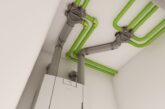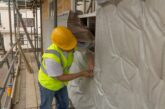
The construction industry is always changing. Whether through new regulations, evolving needs or trends in best practice – professionals must adapt.
For example, according to a recent survey, 41% of housebuilders said they had already adopted 150mm wall cavities in newbuilds. Alongside this change in standard practice, there is a need to use insulation that delivers real performance, can be reliably sourced and has lower embodied carbon.
In this article, we will look at three reasons to start using DriTherm Cavity Slab 32 in 150mm cavities.
A more reliable material
There are few things more frustrating than unexpected costs or a shortage of materials during a project. Recent years have shown that the supply of common insulation products can be volatile, with prices rising dramatically or products becoming unavailable. As fossils fuels decline in use, the market will likely become more unstable, affecting common products such as PIR or XPS boards.
To avoid these logistical headaches, you can use wider cavities with products made in the UK from sustainable materials. For example, DriTherm Cavity Slab 32 is a glass mineral wool product, made using up to 80% recycled glass collected near to the two plants that manufacture it. This helps to keep the supply and price more stable and avoids delays in construction.
Demand for low carbon insulation
Demand is rising for products with low embodied carbon (the emissions released over their whole lifecycle). Stricter regulations are on the horizon, with significant industry support for initiatives like the proposed Part Z Building Regulation, which would ensure embodied carbon is assessed on all projects.
Switching to 150mm cavities allows the use of insulation that is low carbon while still meeting thermal performance requirements. DriTherm Cavity Slab 32 is made from glass mineral wool, which has the lowest embodied carbon of any mainstream insulation material.
DriTherm Cavity Slab 32 also uses ECOSE Technology, Knauf Insulation’s unique bio-based binder that contains no added formaldehyde or phenol. (It is made from natural raw materials that are rapidly renewable and is less energy-intensive to manufacture than traditional binder. And the product is compression packed, further reducing its carbon footprint during transportation and storage.

Real performance under scrutiny
Insulation that delivers real performance is essential for meeting increasingly tight regulations. Building Regulation guidance was updated in 2022 in anticipation of the Future Homes Standard, expected in 2025, which will require a 75-80% reduction in carbon emissions compared to homes built under 2013 regulations. Part L (Conservation of fuel and power) now requires all walls to have a maximum U-value of 0.26 W/m²K.
Increasing cavities to 150mm wide allows housebuilders to use insulation such as mineral wool, which is less prone to air gaps. This reduces heat transfer and maximises thermal performance.

Conclusion
Despite some uncertainty about how regulations will evolve in the next few years, the direction of travel is clear – we should aim to create homes that are comfortable, low-carbon, and affordable to run. DriTherm Cavity Slab 32 is ideal for builders and contractors looking for a reliable, sustainable, low-carbon product that delivers the thermal performance they need.

For further information on Knauf Insulation’s DriTherm Cavity Slab 32 click here
For practical tools and information on meeting Building Regulations click here







